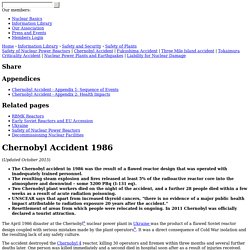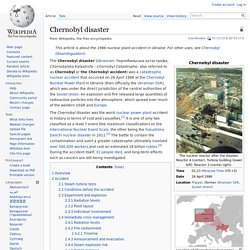

Chernobyl Accident. (Updated October 2015) The Chernobyl accident in 1986 was the result of a flawed reactor design that was operated with inadequately trained personnel.The resulting steam explosion and fires released at least 5% of the radioactive reactor core into the atmosphere and downwind – some 5200 PBq (I-131 eq).Two Chernobyl plant workers died on the night of the accident, and a further 28 people died within a few weeks as a result of acute radiation poisoning.UNSCEAR says that apart from increased thyroid cancers, "there is no evidence of a major public health impact attributable to radiation exposure 20 years after the accident.

"Resettlement of areas from which people were relocated is ongoing. In 2011 Chernobyl was officially declared a tourist attraction. Chernobyl disaster. Location of Chernobyl nuclear power plant The Chernobyl disaster (Ukrainian: Чорнобильська катастрофа, Chornobylska Katastrofa – Chornobyl Catastrophe; also referred to as Chernobyl or the Chornobyl accident) was a catastrophic nuclear accident that occurred on 26 April 1986 at the Chernobyl Nuclear Power Plant in Ukraine (then officially the Ukrainian SSR), which was under the direct jurisdiction of the central authorities of the Soviet Union.

An explosion and fire released large quantities of radioactive particles into the atmosphere, which spread over much of the western USSR and Europe. Fukushima Daiichi nuclear disaster. The Fukushima Daiichi nuclear disaster (福島第一原子力発電所事故, Fukushima Daiichi ( pronunciation) genshiryoku hatsudensho jiko?)

Was a nuclear disaster at the Fukushima I Nuclear Power Plant that began on 11 March 2011 and resulted in a nuclear meltdown of three of the plant's six nuclear reactors.[6] The failure occurred when the plant was hit by a tsunami that had been triggered by the magnitude 9.0 Tōhoku earthquake.[7] The following day, 12 March, substantial amounts of radioactive material began to be released,[8] creating the largest nuclear incident since the Chernobyl disaster in April 1986 and the only (after Chernobyl) to measure Level 7 on the International Nuclear Event Scale[9] (initially releasing an estimated 10–30% of the earlier incident's radioactivity).[10] In August 2013, it was stated[by whom?]
That the significant amount of radioactive water was among the most pressing problems affecting the cleanup process, which is expected to take decades. Overview of the incident[edit]